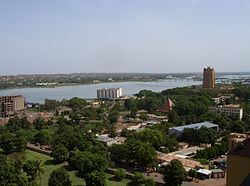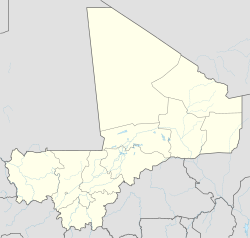Bamako
|
Bamako Bamakɔ |
||
|---|---|---|
| Capital City and Cercle | ||

View of Bamako
|
||
|
||
| Bamako on the Niger River | ||
| Coordinates: 12°39′N 8°0′W / 12.650°N 8.000°W | ||
| Country |
|
|
| Region | Bamako Capital District | |
| Cercle | Bamako | |
| Subdivisions | ||
| Government | ||
| • Type | Capitol District | |
| • Maire du District | Adama Sangaré | |
| Area | ||
| • Capital City and Cercle | 245.0 km2 (94.6 sq mi) | |
| • Metro | 17,141.61 km2 (6,618.41 sq mi) | |
| Elevation | 350 m (1,150 ft) | |
| Population (1 April 2009)(Census, provisional) | ||
| • Capital City and Cercle | 1,809,106 | |
| • Density | 7,384.11/km2 (19,124.8/sq mi) | |
| • Metro | 2,757,234 | |
| • Metro density | 160.85/km2 (416.6/sq mi) | |
| Time zone | Coordinated Universal Time (UTC-0) | |
| ISO 3166 code | ML-BKO | |
Bamako is the capital and largest city of Mali, with a population of 1.8 million (2009 census, provisional). In 2006, it was estimated to be the fastest growing city in Africa and sixth-fastest in the world. It is located on the Niger River, near the rapids that divide the upper and middle Niger valleys in the southwestern part of the country.
Bamako is the nation's administrative center. The city proper is a cercle in its own right. Bamako's river port is located in nearby Koulikoro, along with a major regional trade and conference center. Bamako is the seventh-largest West African urban center after Lagos, Abidjan, Kano, Ibadan, Dakar, and Accra. Locally manufactured goods include textiles, processed meat, and metal goods. Commercial fishing occurs on the Niger River.
The name Bamako (Bàmakɔ̌ in Bambara) comes from the Bambara word meaning "crocodile tail".
The area of the city has evidence of settlements since the Palaeolithic era. The fertile lands of the Niger River Valley provided the people with an abundant food supply and early kingdoms in the area grew wealthy as they established trade routes linking across west Africa, the Sahara, and leading to northern Africa and Europe. The early inhabitants traded gold, ivory, kola nuts, and salt. By the 11th century, the Empire of Ghana became the first kingdom to dominate the area. Bamako had become a major market town, and a centre for Islamic scholars, with the establishment of two universities and numerous mosques in medieval times.
The Mali Empire grew during the early Middle Ages and replaced Ghana as the dominant kingdom in west Africa, dominating Senegal, Gambia, Guinea, and Mauritania. In the 14th century, the Mali Empire became increasingly wealthy because of the trade of cotton, gold and salt. This was eventually succeeded by the Songhai Empire and in the 16th century Berber invaders from Morocco destroyed what remained of the kingdoms in Mali and trans-Saharan trade was taken over by sailors.
...
Wikipedia


